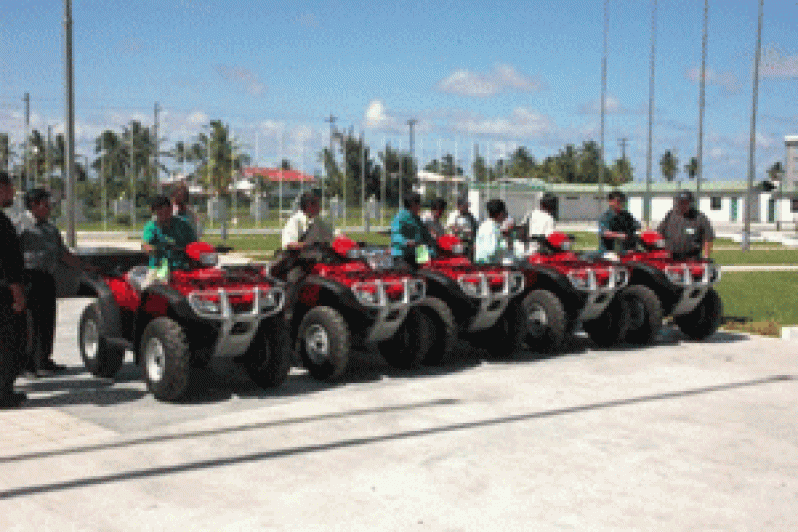UNDER the PPP/C administration the move to ensure that the development of Guyana’s Amerindians is catapulted speedily into the 21st Century has borne fruit and, today, Amerindian leaders are testifying to better lives for their people and development for their communities due to numerous interventions by the Government.
 GRIF
GRIF
he Guyana REDD + Investment Fund (GRIF), a trust fund established between Guyana and Norway in 2010, will finance activities identified under the Low Carbon Development Strategy (LCDS). Funding to the tune of $1.2B will be deposited in the Amerindian Development Fund (ADF) through which an initial $360M will be made available for the execution of projects earmarked under the Community Development Projects (CDPs).
The funding will continue to ensure that land titling and extensions and demarcation of Amerindian lands continue and guarantee the rapid development of solar electrification in hinterland communities. The latter will see information technology being advanced and the enhancement of business opportunities set up under CDPs.
Transportation
Improved transportation accessibility in hinterland communities has aided the transformation of village economies while bridging the development gap between Guyana’s hinterland and coastland regions.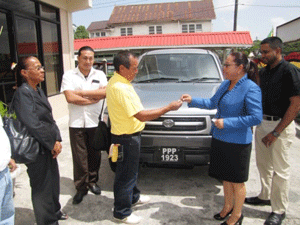 Vehicles have been purchased through Presidential Grants for a number of villages in the hinterland which allow for the transport of farmers’ produce and villagers to market and children to and from school. Several communities have benefitted from minibuses, pick-ups, boats, tractors to bolster agricultural activities and All Terrain Vehicles (ATVs). Improved roads have given way to more economic activities, as it becomes easier and less costly to transport agricultural produce to the coast.
Vehicles have been purchased through Presidential Grants for a number of villages in the hinterland which allow for the transport of farmers’ produce and villagers to market and children to and from school. Several communities have benefitted from minibuses, pick-ups, boats, tractors to bolster agricultural activities and All Terrain Vehicles (ATVs). Improved roads have given way to more economic activities, as it becomes easier and less costly to transport agricultural produce to the coast.
Road networking
Last year, $20B saw the continuation of the hinterland roads project which encompasses 600 miles of interior road networks linking Amerindian communities to centres of commercial and social activities. Region One, received $1.3B to facilitate rapid development of road networks to bridge the distance between hinterland communities in that region.
The previous year, $1B was spent in developing various hinterland roads, inclusive of Lethem, Aishalton, Meritzero Junction, Karasabai, Ituni/Kwakwani, and Santa Rosa. The communities of Matthews Ridge, Port Kaituma and 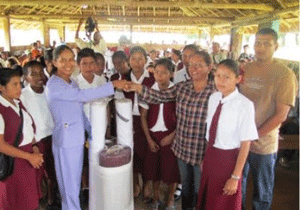 Baramita have already been linked through the hinterland road strategy providing easier access for persons and goods to travel. Another road connecting the Manawarin and Macabra villages which could not be easily accessed will be completed shortly.
Baramita have already been linked through the hinterland road strategy providing easier access for persons and goods to travel. Another road connecting the Manawarin and Macabra villages which could not be easily accessed will be completed shortly.
The Matarkai Sub-Region of Region One the Matthews Ridge to Baramita road now allows for easy transportation to Baramita, which was once a very remote community that could only have been accessed by airplane or after an 8 to 10 hour trek.
Works on the Yarakita road have also commenced while access to several communities including Kamwatta, White Water and Wauna is now easier while a massive infrastructure project of $600 M will improve accessibility into Region Nine.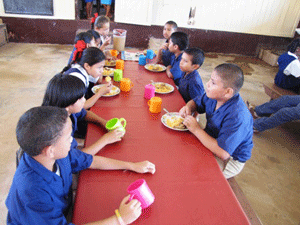 Linking the hinterland and the coastland will be facilitated through the road from Linden to Lethem for which $291M was budgeted last year. An additional sum of US$1.1M was invested for the completion of a feasibility study for the construction of a four-lane all-weather road from Georgetown to Lethem.
Linking the hinterland and the coastland will be facilitated through the road from Linden to Lethem for which $291M was budgeted last year. An additional sum of US$1.1M was invested for the completion of a feasibility study for the construction of a four-lane all-weather road from Georgetown to Lethem.
Over the past year, close to $700M in contracts were awarded for the construction and upgrade to roads and structures in Regions 7, 8 and 9.
Education transformation
Heavy investment in education has seen much wider access not only to formal education but at the technical, vocational and university levels for the fast rising Amerindian population and other Guyanese.
Hundreds of schools, primary and nursery, have been built in the hinterland regions making it easier for children to 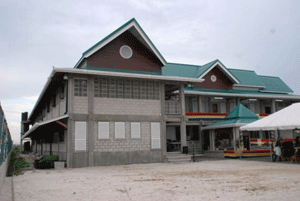 access education closer to their villages, while several secondary schools have also been constructed as the Administration makes strides in increasing the percentage of children accessing education at this level. Among the secondary schools are; Aishalton and St Ignatius in Region Nine, Four Miles, Bartica and Waramadong, Region Seven, Paramakatoi, Region Eight, Mabaruma, Region One and St Cuthbert’s Region Four. The most recently built school is at Sand Creek, Region Nine.
access education closer to their villages, while several secondary schools have also been constructed as the Administration makes strides in increasing the percentage of children accessing education at this level. Among the secondary schools are; Aishalton and St Ignatius in Region Nine, Four Miles, Bartica and Waramadong, Region Seven, Paramakatoi, Region Eight, Mabaruma, Region One and St Cuthbert’s Region Four. The most recently built school is at Sand Creek, Region Nine.
All these schools have dormitories to cater for students from far off areas.
The formative years of a person’s development are critical and as such Government is providing a nutritional diet for students in hinterland communities with a hot meal from nursery to Grade Two. The hot meals and cassava bread and juice programme were implemented in the Hinterland communities, in Regions 1, 7, 8, and 9.
The programme was initially implemented through the Ministry of Education’s Fast Track Initiative (EFA/FTI) in a number of communities in Region Nine and was expanded to include additional regions.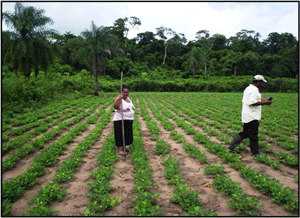 The hinterland school uniform programme was initiated in 2003 to boost school attendance, to ensure children acquire an education. Raw materials are distributed to hinterland communities, while contracts for the sewing of the uniforms are awarded to residents of the respective villages.
The hinterland school uniform programme was initiated in 2003 to boost school attendance, to ensure children acquire an education. Raw materials are distributed to hinterland communities, while contracts for the sewing of the uniforms are awarded to residents of the respective villages.
The new Students’ Dormitory at Liliendaal caters for approximately 120 students from the hinterland, who have been awarded scholarships.
The students being under one roof are more effectively supervised and they support their peers both academically and socially. The dormitory also provides medical care for students who may fall ill, computer training and internet access, library facilities, games, development of farm plots and other extra curricula activities.
Hinterland Scholarship
Over the past 11 years, more than 450 students have benefitted from scholarships while scores more have accessed 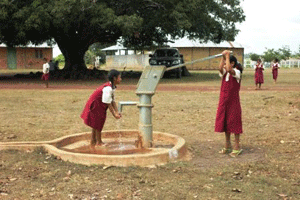 technical and tertiary education at institutions such as the GSA, GTI, Carnegie School of Home Economics and the University of Guyana.
technical and tertiary education at institutions such as the GSA, GTI, Carnegie School of Home Economics and the University of Guyana.
The Caribbean Secondary Education Certificate Examination (CSEC) written by hinterland students has recorded 90.4 percent passes in grades 1 to 3 and, many of the graduating scholarship students have returned to their Regions and are today serving in the post of Education Officer, Graduate/ Trained Head Teacher, Doctor, Medex, Dentex, Staff Nurse, Midwife, Engineer, Lawyer.
Several are also in Cuba undergoing training in various disciplines.
Health
Twenty years of wide ranging national health transformation, supported by successive, annual multi-billion dollar budgets, has focused on infrastructural development and personnel upgrade, around the country and in Amerindian communities.
Mabaruma and Kumaka, Region One and Lethem Hospital complex, Region Nine is outfitted with modern equipment and facilities including theatres, in-patient and out-patient facilities, pharmacy and laboratory.
New health centres were built where none existed previously, staffed with adequate medical personnel in every hinterland area that offers health care services which were unavailable in the past whilst prior services, have been upgraded.
Several Medex Training Programmes conducted by the Ministry of Health have seen many Amerindians returning to their communities to serve in these positions.
Agriculture
From largely subsistence farming, involving mostly cassava, technology has been introduced to enhance the production of this staple, with an eye towards export markets.
There is a vibrant peanut and vegetable programme in Regions One and Seven; a multimillion dollar rice and beans project at Moco Moco, Region Nine that will supplement the development of the Rupununi; and a promising cultivation of spices, inclusive of black pepper, nutmeg, and tumeric in Regions One, Seven and Eight.
These projects are supported by NAREI through the training of Amerindians in modern agriculture methods such as laboratory techniques for soil testing; pests and diagnosis control and improved irrigation methods; as well as a shade house for cultivation in a controlled environment.
The National Hinterland Secure Livelihood Programme (NSLP) is ongoing in 15 communities in Region One, apart from others in Regions Seven and Nine. Costing $180M, the NSLP emphasises the establishment of sustainable agriculture ventures, generating income, providing employment, whilst introducing scientific methods that enhance production yields.
Potable water
Amerindian communities are accessing more potable water as the government strives to meet the United Nations’ Millennium Development Goals (MDGs) among which is halving the proportion of people without sustainable access to safe drinking water by 2015.
Residents in most Hinterland regions are receiving potable water as new boreholes have been completed in several Regions while PVC systems have also been installed along with new distribution systems and the completion of elevated storage facilities.
Several communities have received black tanks for storage of potable water. Additionally, in some communities, there has been the installation of solar pumping systems.
Wells fitted with hand pumps and rainwater catchments are installed in a majority of the villages and Government provides funds to rehabilitate and repair the systems.
Electricity
The aggressive pursuit of the Hinterland Electrification Project includes distribution of 11,000 solar panels to Amerindian communities that cannot be connected to the national grid.
This will boost economic ventures and allow for children to complete assignments and be involved in more advantageous ventures.
The Programme is linked to Amaila Falls Hydropower project which is a major aspect of government’s Low-Carbon Development Strategy.
Amerindian Act
The Amerindian Act of 2006 followed the establishment of the first Ministry of Amerindian Affairs in Guyana. Together, they allow for policy measures to promote the expression and development of culture and languages whilst building awareness of the rich culture of the first peoples of Guyana.
Further, the principle of collective rights and the revised Amerindian Act of 2006 created the legal regime for the protection and enforcement of collective rights to land and internal self-government. The Mining and Forest Acts for instance respect Amerindians’ traditional rights to lands and the Environmental Protection Act ensures that traditional activities are not constrained.
NTC, IPC
The National Toshaos Council (NTC) also has the mandate to propose policies on Amerindian welfare and allows leaders the opportunity to meet under one roof, to have discussions at the highest level.
The most recent NTC meeting in August 2012 saw the election of a new executive body, chaired by Derrick John. It also saw the signing of an agreement for the release of the Guyana Redd+Investment fund (GRIF), through which Amerindian Development will take centre stage.
The IPC’s mandate is to establish mechanisms to enhance the status of indigenous peoples and to respond to their legitimate demands and needs.
Specific areas of focus include the promotion and protection of the rights of indigenous people, awareness raising of the contributions and problems facing indigenous people and the promotion of empowerment of indigenous people regarding village councils in the local government system.
The elevation of Amerindians in Guyana to high public office in Government has been a significant hallmark of the PPP/C administration, and they are being elevated at all levels of both the local and international scenes through the opportunities being offered to them.
Among them are; Ashton Simon- Indigenous Relations Specialist at Ministry of Natural Resources & the Environment; Carolyn Rodrigues-Birkett – Minister of Foreign Affairs; Pauline Sukhai, current Minister of Amerindian Affairs; and Bertie Xavier – member of the United Nations Permanent Forum on Indigenous Issues (UNPFII). Vibert De Souza was appointed the first Minister of Amerindian Affairs by the PPP/C administration while the late Dr. Desrey Fox served as Minister in the Ministry of Education.
Legislation and Amerindian rights
The catalyst for supporting Amerindian rights was the passage of the Amerindian Act that has ensured that every facet of Amerindians’ political, social and economic rights, in addition to being fulfilled, is also practically executed via the many structures of governance established.
It started with the pivotal issue of land titling, where government has set the policy objective of resolving all land titling issues by 2015, for all Amerindian villages.
Also, the extension of Amerindian lands is guided by the legislative process governing such activity, and which is clearly defined by the relevant articles of the Amerindian Act#6 of 2006.





.jpg)


